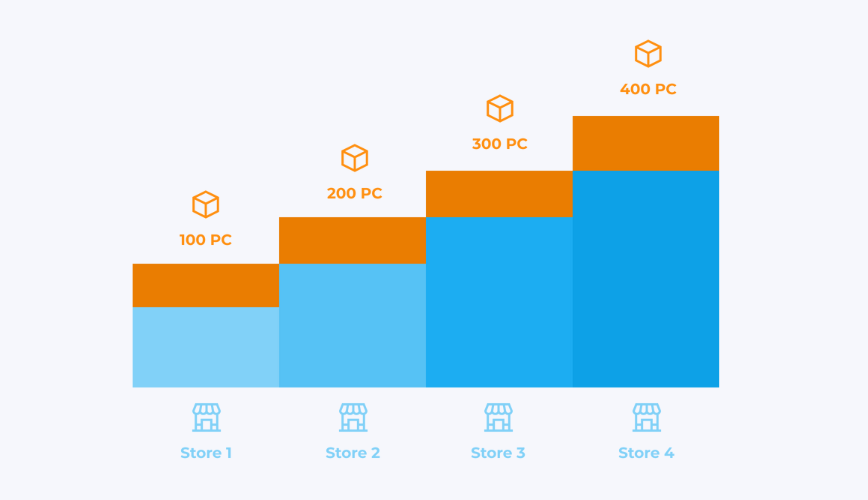According to Statista, 83% of shoppers compare prices before purchasing online. In the e-commerce market, where price often plays a decisive role, staying competitive requires implementing a competitive pricing strategy. This involves setting product prices based on those of your competitors, enabling you to maintain your market position, attract new customers, and uncover growth opportunities.
To successfully adopt competitive pricing, you must balance market demand with your desired profitability. In this article, we explore three crucial pricing factors you should consider to ensure your pricing appeals to customers while achieving your revenue goals.
Contents:
Factor #1: The Market
Factor #2: Cost of Goods Sold (COGS) and Margin
Factor #3: The Premium Factor
How to Track Market Conditions for Successful Competitive Pricing
Factor #1: The Market
When it comes to pricing, “the market” isn’t just a collection of stores that sell products. It’s a complex system of interactions among all participants: consumers, sellers, suppliers, and manufacturers.
The market is the environment where these interactions occur, shaped by supply and demand, market trends, and broader economic conditions. Pricing strategies cannot exist in isolation from market dynamics — external conditions that define the boundaries within which prices can be set.
A classic example of this is holiday sales. Around Black Friday, many large retailers offer significant discounts. To stay competitive and meet sales targets, other e-commerce players are compelled to join in, adopting similar pricing strategies.
Let’s delve deeper into the market factors that influence pricing.
Economic Conditions
Economic conditions encompass factors such as inflation, currency fluctuations, and tax or regulatory policies. For instance, inflation may compel businesses to increase prices to protect their profit margins. Similarly, shifts in exchange rates can impact the cost of imported goods or raw materials, often requiring companies to adjust prices to sustain profitability. Additionally, changes in tax or regulatory policies, such as increased tariffs or stricter compliance requirements, can significantly affect costs, leading businesses to modify their pricing strategies to maintain financial stability.
Supply and Demand
Supply and demand are the two main forces that determine market prices.
If demand for a product exceeds supply, its price usually increases. For example, when a new electronic device is launched, demand is often so high that a company can afford to set a higher price and maximize profits using a price skimming strategy.
On the other hand, if supply exceeds demand, companies are forced to lower prices to attract buyers. In such cases, sellers may engage in price wars to create higher demand and, as a result, maintain their market share.
Changes in supply and demand create price fluctuations and require companies to constantly analyze the market. If a competitor offers a promotion or significantly reduces prices, you need to react quickly to avoid losing customers.
Seasonal Fluctuations
Prices in certain product categories (such as clothing and footwear, tourism services, agricultural products, and air conditioning equipment) fluctuate by season. For example, demand for air conditioners spikes during the summer months, often leading companies to raise prices.
Competitive Landscape
The competitive landscape is a critical factor in shaping your pricing strategy. For instance, when a major online electronics retailer introduces steep discounts, other retailers must respond to avoid significant customer churn.
If your niche is dominated by large discounters or numerous mid-range competitors offering low prices, you may need to align your pricing strategy with theirs to stay competitive. However, if competing on price is neither feasible nor profitable, differentiation becomes essential. This can be achieved through a unique product assortment, exclusive offers, enhanced services, or effective marketing strategies.
Competitors’ pricing strategies serve as a key benchmark for businesses, offering valuable insights into market expectations and opportunities for positioning.
The success of a competitive pricing strategy largely depends on how well employees responsible for pricing understand the importance of systematic market monitoring. It also hinges on whether they have a clear methodology and the right tools to effectively analyze competitors.
According to our research among companies across various online retail sectors:
- 72.7% of sales department employees analyze competitors to identify market trends, uncover new growth opportunities, and find ways to differentiate.
- However, only 36.4% of these companies use automated tools to monitor competitors’ prices daily.
These findings highlight a gap between recognizing the value of competitor analysis and implementing efficient, consistent practices to leverage it.
Modern price monitoring tools enable businesses to swiftly adapt to market changes. Platforms like Pricer24 allow companies to not only automate the collection of competitor pricing data but also quickly reassess their product lines in response to market shifts.
If you’re interested in how automation can streamline price adjustments, explore our case study on dynamic pricing for scaling home appliance sales, where we delve into this process in detail.
Factor #2: Cost of Goods Sold (COGS) and Margin
Cost of Goods Sold (COGS) and Margin are critical pricing factors that help retailers set both minimum and optimal prices, ensuring profitability while staying competitive.
What Is COGS and Why Is This Pricing Factor Important?
Cost of Goods Sold (COGS) encompasses all direct costs associated with the production or purchase of goods, including raw materials, production, labor, transportation, and packaging. For category managers, understanding COGS is essential because it helps to determine the minimum price at which a company can cover its costs. Setting a price lower than COGS results in losses.
Considering Margin in Pricing
To ensure profitability, retailers must consider their margins. The margin is the percentage difference between the selling price and COGS, which allows the business to cover indirect costs (such as marketing and commissions) and generate net profit.
Using the margin, retailers can calculate the optimal price for each product using this formula:
Optimal price = COGS / (1 − margin)
Example: Let’s say the COGS for wireless headphones is $40 (which includes the components, housing, assembly, packaging, and shipping). If the desired margin is 50%, the optimal selling price would be:
Optimal price = $40 / (1 − 0.5) = $40 / 0.5 = $80
In this case, the optimal selling price is $80, which ensures that the company covers its COGS of $40, achieves a 50% margin, and remains competitive in the market.
The optimal price ensures the company covers its costs, meets its margin goal, and remains competitive. This is crucial for e-commerce, where competition often forces a balance between profitability and market competitiveness.
If the market price matches the optimal price, the company can achieve its planned profitability. However, if the market price is lower than the optimal price, the company will need to find ways to reduce COGS, such as by optimizing supplies or cutting costs.
Relationship Between Market and Optimal Prices
The market price, shaped by competitor analysis and market conditions, may be higher or lower than the optimal price. In highly competitive markets, especially in e-commerce, businesses must carefully balance the optimal price to ensure profitability while remaining competitive enough to attract buyers.
If the market price exceeds the optimal price, companies can increase profitability without sacrificing competitiveness. However, if the market price is significantly lower than the optimal price, the company must either reduce costs or improve sales efficiency to remain profitable.
Continuous market monitoring and the use of automated tools to adjust prices in real time are essential for optimizing pricing strategies and ensuring sustainability in a competitive environment.
To learn more about market pricing, read our article: E-commerce Pricing: How to Scale and Grow.
Factor #3: Premium Factor
The premium factor is a pricing strategy that allows a seller to set higher prices than competitors based on a product’s unique advantages or added value. This approach is used when a product offers something exceptional that justifies its higher price.
Typically, consumers are willing to pay more for products that offer exceptional quality, exclusivity, innovation, or status, or those that evoke emotions or experiences that competing brands cannot offer. Well-known examples include premium brands like Apple, Dyson, Tesla, Rolex, and Perrier. These brands create a strong emotional connection with customers, making them willing to pay a premium for their products.
In e-commerce, the premium factor is not always directly tied to the product’s intrinsic characteristics. Many online stores sell identical products, so the competitive advantage often comes from the customer experience and additional services. Here are some examples of how e-commerce businesses leverage the premium factor:
- Amazon Prime: Subscribers enjoy exclusive discounts, free delivery within 1–2 days, and access to a variety of media content.
- Zappos: The company offers a unique return policy — 365 days to exchange or return items — providing customers peace of mind and a premium experience.
- Sephora: The Beauty Insider program gives customers free delivery, early access to new products, discounts, and gifts with purchases.
By offering these additional services, e-commerce brands can not only justify higher prices but also build customer loyalty and sustain competitiveness.
How to Track Market Price Factors
To effectively implement a competitive pricing strategy, it’s crucial to constantly monitor and analyze the market. Keeping your finger on the pulse means staying informed about your competitors’ pricing strategies, seasonal fluctuations in supply and demand, and other key market dynamics. Without regular monitoring, you risk losing customers and profit to competitors who are better aligned with market conditions.
Key benefits of regular market monitoring:
- Understand the current market situation: Stay up to date on supply and demand shifts, economic changes, and consumer trends.
- Identify price trends: Detect rising or falling trends in pricing and adjust your strategy to remain competitive.
- Respond to competitors’ promotions and sales: Quickly react to flash sales, discounts, or special promotions from competitors to avoid losing market share.
- Maximize sales during competitor stockouts: If competitors are temporarily out of stock of a popular product, adjust your pricing to capture their customers.
- Find gaps in competitors’ pricing strategies: Identify weaknesses in competitors’ pricing tactics and exploit these gaps to your advantage.
Automating Price Monitoring and Adjustments
Tracking these factors manually is a daunting and time-consuming task, especially as it involves collecting and processing large amounts of data. This is where price monitoring tools, such as Pricer24, come into play.
Price monitoring tools automate data collection and allow for quick adjustments based on real-time market conditions. Here’s how Pricer24 works:
- Real-time data collection: Pricer24 collects pricing data from multiple sources, such as competitors’ websites and e-commerce platforms.
- Automated price adjustments: Based on predefined rules and market analysis, Pricer24 can adjust prices automatically. For example, if demand for a particular product surges, it can automatically increase prices to maximize revenue. Conversely, if competitors run a flash sale, it can allow you to quickly adjust your prices to remain competitive.
By using tools like Pricer24, you can ensure that your business remains agile, continuously adapting to market changes while optimizing prices for maximum profitability.
Conclusion
A competitive pricing strategy is a powerful tool for maintaining your market position and achieving desired profitability. However, its successful implementation requires a thorough understanding of market conditions, precise calculations of costs and margins, and strategic use of a premium factor to offer added value to customers. By carefully analyzing these key aspects, online stores can effectively balance profitability and competitiveness, ensuring long-term success in a dynamic market environment.
Incorporating regular market monitoring, using automated pricing tools, and responding quickly to changes in supply, demand, and competitor actions will help you maintain the balance between profitability and competitiveness and ensure your pricing strategy stays aligned with current trends and customer expectations.









